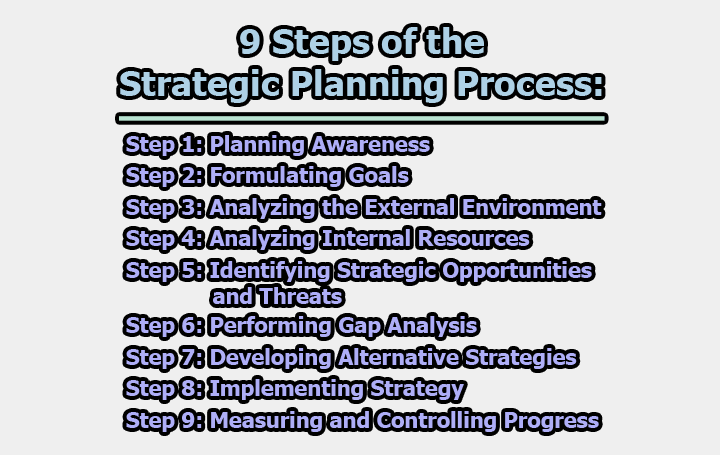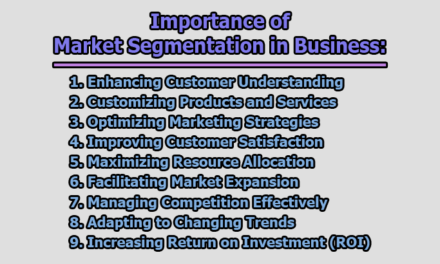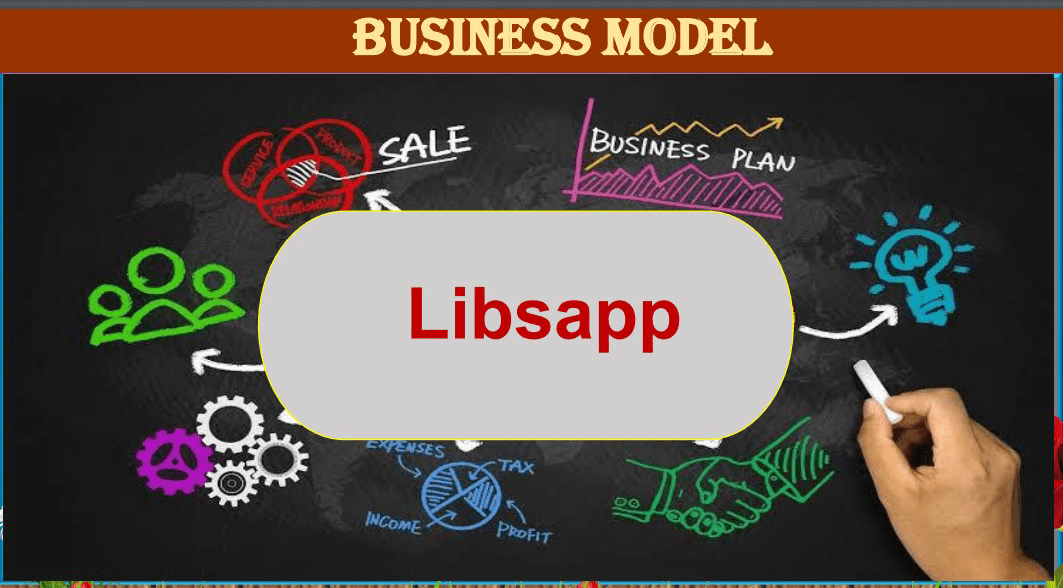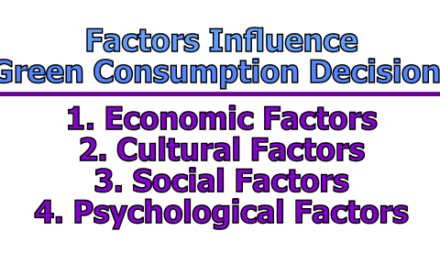9 Steps of the Strategic Planning Process:
Developing and implementing a strategic plan is a critical process for organizations of all types and sizes. A well-structured strategic planning process can help an organization define its goals, analyze its internal and external environments, identify opportunities and threats, and ultimately create a roadmap for success. In this article, we will explore the 9 steps of the strategic planning process.
Step 1: Planning Awareness: Planning awareness is the crucial initial phase of the strategic planning process, and it sets the stage for successful planning and implementation. Here’s a deeper look:
1.1 Education and Communication: The goal is to ensure that everyone involved in the organization understands what strategic planning is and why it’s essential. This involves conducting workshops, seminars, or training sessions to educate key stakeholders about strategic planning concepts, methodologies, and its benefits. Effective communication is key to making sure that all levels of the organization, from top management to front-line employees, have a shared understanding of the process.
1.2 Create a Sense of Purpose: Beyond just explaining the mechanics of strategic planning, leaders must articulate the purpose and relevance of the process. Stakeholders should understand that strategic planning isn’t just another corporate exercise; it’s a means to achieve the organization’s mission and vision. Highlight how strategic planning provides a roadmap to achieve long-term goals and navigate through challenges and uncertainties effectively.
1.3 Engage Stakeholders: Strategic planning should not be a top-down process. It’s vital to involve a diverse range of stakeholders in the awareness-building phase. This includes senior executives, middle management, front-line employees, board members, and even external partners or customers, depending on the organization’s structure. Engaging stakeholders from various levels and functions fosters a sense of ownership and ensures that different perspectives are considered during the planning process.
1.4 Gather Input: Encourage stakeholders to share their insights, concerns, and aspirations related to the organization’s future. Listening to their input not only demonstrates that their voices are valued but also provides valuable information that can inform the strategic planning process. Conduct surveys, focus groups, or one-on-one interviews to collect this input.
Step 2: Formulating Goals: The second step in the strategic planning process involves setting clear and meaningful goals for the organization. Here’s a dive into this critical phase:
2.1 S.M.A.R.T. Goals: When formulating goals, organizations should follow the S.M.A.R.T. framework, which stands for Specific, Measurable, Achievable, Relevant, and Time-bound.
- Specific: Goals should be precise and well-defined. Rather than a vague objective like “increase revenue,” a specific goal would be “increase quarterly revenue by 10%.”
- Measurable: Goals should include metrics or criteria to measure progress and success. Using quantifiable indicators allows for tracking and evaluation.
- Achievable: Goals should be realistic and attainable with the available resources and within the given timeframe. While ambitious goals can be motivating, they must also be achievable.
- Relevant: Goals should align with the organization’s mission and long-term vision. They should be directly tied to the organization’s overall purpose and strategic priorities.
- Time-bound: Goals should have a clear timeline or deadline for accomplishment. This helps in monitoring progress and ensures accountability.
2.2 Alignment with Mission and Vision: Goals should be in harmony with the organization’s mission and vision statements. They should reflect what the organization aspires to achieve in the long run. When goals align with these guiding statements, they give direction and purpose to the organization’s efforts.
2.3 Prioritization: Not all goals are equally important or urgent. Prioritization is critical to focus efforts and resources on the most strategic objectives. Organizations should consider the impact, feasibility, and dependencies of each goal when determining their priority.
2.4 Inclusivity: Involving a cross-section of stakeholders in the goal-setting process can lead to more well-rounded and comprehensive objectives. Different perspectives can uncover opportunities and challenges that might have been overlooked otherwise.
Step 3: Analyzing the External Environment: Understanding the external environment is essential to make informed strategic decisions. This step involves in-depth research and analysis of various external factors that may impact the organization. Here’s a breakdown:
3.1 Market Analysis: Examine the current state of the market in which the organization operates. This includes assessing market size, growth trends, customer preferences, buying behavior, and competitive landscape. Consider conducting market surveys, competitor benchmarking, and industry research.
3.2 Economic Factors: Economic conditions can significantly influence an organization’s strategy. Evaluate factors such as inflation rates, interest rates, unemployment rates, and overall economic stability. Understand how these factors may affect consumer spending, demand for products or services, and the cost of doing business.
3.3 Regulatory and Legal Landscape: Laws and regulations can impact various aspects of an organization’s operations, from product safety standards to data privacy regulations. Organizations must stay informed about current and potential regulatory changes that could affect their industry or market.
3.4 Technological Advancements: Technology is advancing rapidly, and it can both create opportunities and pose threats to organizations. Analyze emerging technologies that could disrupt the industry or enhance operations. Assess the organization’s technology infrastructure and its ability to adapt to technological changes.
3.5 Social and Cultural Trends: Changes in societal attitudes, values, and behaviors can have a profound impact on consumer preferences and market dynamics. Consider social trends related to sustainability, diversity and inclusion, health and wellness, and other relevant factors.
3.6 Competitive Intelligence: Understand the competitive landscape thoroughly. Identify key competitors, their strengths and weaknesses, market share, and strategies. Analyze how competitors may respond to changes in the external environment and how that might impact your organization.
3.7 SWOT Analysis: Combine the insights gathered from market analysis, economic assessment, regulatory analysis, and other external factors into a SWOT analysis (Strengths, Weaknesses, Opportunities, Threats). This provides a consolidated view of the organization’s position in relation to its external environment.
Step 4: Analyzing Internal Resources: This step focuses on assessing the organization’s internal capabilities and resources. A comprehensive internal analysis helps identify strengths and weaknesses, guiding strategic decisions. Here’s a closer look:
4.1 Strengths Analysis: Identify the organization’s core strengths and unique competencies. These could include specialized knowledge, skilled workforce, strong brand reputation, or proprietary technologies. Understanding these strengths is crucial for leveraging them in the strategic planning process.
4.2 Weaknesses Assessment: Examine areas where the organization may be lacking or underperforming. Weaknesses could encompass gaps in skills, outdated technologies, inefficient processes, or a lack of financial resources. Recognizing weaknesses is the first step toward addressing and mitigating them.
4.3 Resource Allocation: Analyze how resources, including financial assets, human capital, and technology, are currently allocated within the organization. Ensure that resources align with strategic priorities and that they are being utilized efficiently to support the achievement of goals.
4.4 Operational Efficiency: Evaluate internal processes and workflows. Identify opportunities to streamline operations, reduce costs, and improve overall efficiency. A well-optimized internal environment can free up resources for strategic initiatives.
4.5 Culture and Organizational Structure: Assess the organization’s culture and its alignment with strategic goals. Culture can impact decision-making, employee motivation, and the organization’s ability to adapt to change. Evaluate whether the existing organizational structure supports the strategic direction.
Step 5: Identifying Strategic Opportunities and Threats: Building on the analysis of the external environment and internal resources, this step involves pinpointing specific strategic opportunities and threats:
5.1 Opportunity Identification: Identify areas where the organization can gain a competitive advantage or create value. Opportunities might involve entering new markets, launching innovative products, expanding partnerships, or tapping into emerging trends.
5.2 Threat Recognition: Recognize potential obstacles or threats that could hinder progress. Threats may include increased competition, economic downturns, supply chain disruptions, changing customer preferences, or regulatory changes.
5.3 SWOT Synthesis: Combine the findings from the internal resources analysis (Step 4) and the external environment analysis (Step 3) to create a refined SWOT analysis. This updated SWOT matrix can provide a clear picture of the organization’s strategic position and the key areas to address.
5.4 Benchmarking: Compare the organization’s performance and capabilities against industry benchmarks and best practices. Benchmarking helps identify areas where the organization lags behind or excels compared to peers.
5.5 Scenario Planning: Consider different scenarios based on the identified opportunities and threats. Scenario planning helps organizations prepare for a range of possible futures and develop strategies that are robust and adaptable in various circumstances.
Step 6: Performing Gap Analysis: Gap analysis is a crucial bridge between the identification of strategic opportunities and the development of specific strategies to pursue those opportunities. Here’s an exploration of this step:
6.1 Gap Definition: Clearly define the gaps that exist between the organization’s current state (as identified in the internal resources analysis) and its desired future state (as determined by strategic goals and opportunities). These gaps can pertain to skills, resources, technology, or any other relevant aspect.
6.2 Quantify Gaps: Whenever possible, quantify the gaps to make them more tangible and measurable. For example, if the goal is to increase market share by 15%, but current market share is only at 8%, this quantifies the gap.
6.3 Prioritization of Gaps: Not all gaps are of equal importance. Prioritize the identified gaps based on their impact on the organization’s ability to achieve its strategic objectives. High-priority gaps require immediate attention and resource allocation.
6.4 Resource Allocation: Align resources with the prioritized gaps. Determine which resources (financial, human, technological) are needed to address the gaps effectively. This informs resource allocation decisions in the subsequent steps of the strategic planning process.
6.5 Action Planning: Develop specific action plans to address each prioritized gap. These plans should outline the steps, responsibilities, timelines, and resources required to close the gaps.
Step 7: Developing Alternative Strategies: In this phase, organizations explore and formulate various strategies to address the identified gaps and leverage opportunities. Here’s a brief look at this crucial step:
7.1 Brainstorming and Creativity: Encourage a creative and open-minded approach to generate a wide range of strategic options. Brainstorming sessions involving key stakeholders can be valuable for generating fresh ideas.
7.2 Diverse Perspectives: Involve individuals from various departments and levels within the organization to contribute to the strategy development process. Diverse perspectives can lead to innovative and well-rounded strategies.
7.3 Risk Assessment: Evaluate the potential risks associated with each strategy. Consider factors such as market volatility, resource requirements, competitive response, and external threats. Understanding the risks allows organizations to develop risk mitigation plans.
7.4 Alignment with Mission and Values: Ensure that all proposed strategies align with the organization’s mission, values, and long-term vision. Strategies should not only address gaps but also be consistent with the organization’s overarching purpose.
7.5 Feasibility: Assess the feasibility of each strategy in terms of the organization’s capabilities and available resources. Evaluate whether the organization has the skills, infrastructure, and financial means to execute the chosen strategies.
7.6 Scenario Planning: Consider how each strategy might play out in different scenarios, including best-case and worst-case scenarios. This can help organizations anticipate potential challenges and make informed decisions.
Step 8: Implementing Strategy: After selecting the most promising strategies, organizations must translate them into action. Successful implementation is essential for realizing strategic goals. Here’s a closer examination of this phase:
8.1 Detailed Implementation Plans: Develop detailed action plans for each selected strategy. These plans should outline specific tasks, responsibilities, timelines, and resource allocations. Clarity is essential to ensure that everyone involved knows what is expected.
8.2 Resource Allocation: Allocate resources, including budget, personnel, and technology, to support the implementation of the chosen strategies. Adequate resource allocation is critical for effective execution.
8.3 Communication and Engagement: Communicate the strategic plan and implementation details to all relevant stakeholders. Ensure that employees understand their roles and how their contributions connect to the organization’s broader strategic goals. Engaged and motivated employees are more likely to drive successful implementation.
8.4 Monitoring and Feedback: Establish mechanisms for ongoing monitoring and feedback. Regularly track progress against the implementation plans and key performance indicators (KPIs). Encourage feedback from employees and other stakeholders to identify issues and make necessary adjustments.
8.5 Adaptability: Be prepared to adapt the implementation plans as needed. External factors, unexpected challenges, or changes in the business environment may require adjustments to strategies or tactics. Flexibility is a crucial aspect of effective implementation.
Step 9: Measuring and Controlling Progress: The final step in the strategic planning process focuses on assessing progress, ensuring accountability, and making informed adjustments. Here’s an exploration of this phase:
9.1 Key Performance Indicators (KPIs): Define and track KPIs that align with the organization’s strategic goals. These KPIs should provide a clear view of progress and success. Examples of KPIs may include revenue growth, customer satisfaction scores, or market share.
9.2 Regular Evaluation: Continuously evaluate performance against established KPIs and targets. Regular assessments provide insights into what is working well and where improvements are needed.
9.3 Feedback Loops: Create feedback mechanisms to gather insights from employees, customers, and other stakeholders. Feedback can reveal issues or opportunities that may not be apparent through quantitative metrics alone.
9.4 Decision-Making: Use the data and feedback collected to inform decision-making. When performance falls short of expectations or when new opportunities arise, organizations can make informed adjustments to the strategic plan.
9.5 Continuous Improvement: Embrace a culture of continuous improvement. Encourage a mindset of learning from both successes and failures. Celebrate achievements and use setbacks as opportunities to refine strategies and processes.
9.6 Alignment with Goals: Ensure that all actions and initiatives undertaken during implementation align with the organization’s strategic goals. Regularly assess whether activities contribute to the achievement of those goals.
9.7 Reporting and Transparency: Communicate progress and results transparently to all stakeholders. Transparency fosters trust and accountability within the organization and among external partners.
9.8 Strategic Reviews: Periodically conduct strategic reviews to assess the overall effectiveness of the strategic plan. These reviews can lead to adjustments in the plan or the identification of new strategic initiatives.
In conclusion, the 9 steps of the strategic planning process constitute a comprehensive framework that empowers organizations to navigate the complex terrain of today’s business landscape successfully. From the foundational phases of building awareness and formulating clear goals to the rigorous analyses of both external and internal environments, these steps provide a structured pathway for organizations to chart their course. Identifying strategic opportunities and threats, performing gap analysis, and developing alternative strategies are essential elements that bridge the gap between envisioning the future and bringing it to fruition. Implementing strategies with precision and diligence, combined with vigilant measurement and control, ensures that the organization remains agile and adaptable in the face of change. Furthermore, the considerations of external and internal consistency, competitive advantage, risk management, societal impact, and motivation provide critical dimensions for evaluating a strategy’s effectiveness and relevance. By meticulously following these steps and embodying a commitment to continuous improvement, organizations can craft and execute strategies that drive their enduring success and responsiveness in an ever-evolving world.

Library Lecturer at Nurul Amin Degree College










